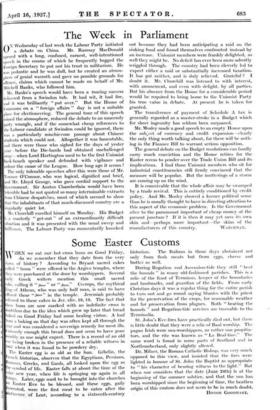Some Easter Customs .
IIEN we eat our hot cross buns on Good Friday, do we remember that they date from the very lawn of history ? According to Bryant sacred cakes ailed " boun " were offered in the Argive temples, where hey were purchased at the door by worshippers. Several rly Greek writers mention this small sacred .eke, calling it " pow. " or " row." Cecrops, the mythical ng of Athens, who was only half man, is said to have tiered these "pow" in the temple. Jeremiah probably eferred to these cakes in Jer. xliv. 18,19. The fact that hese buns are now marked with an indefinite cross is louhtiess due to the idea. which grew up later that bread aked on Good Friday had some healing virtue. A loaf rota a baking on that day was often kept all through the ear and was considered a sovereign remedy for most ills. urionsly enough this bread does not seem to have gone ouldy as one might expect. There is a record of an old ne being broken in the presence. of a reliable witness in 887 when it was found to be powdery dry. The Easter egg is as old as the bun. Gebelin, the retch historian, observes that the Egyptians, Persians, omans, Greeks, and Gauls, all looked upon the egg as he symbol of life. Faster falls at about the time of the lar new year, when life is springing up again in all lungs- Later, eggs used to be brought into the churches Easter Eve to be blessed, and these eggs, gaily emrated, were the first meat to be eaten after the tinenee_ of Lent, according to a sixteenth-century historian. The Italians in those days abstained not only from flesh meats but from eggs, cheese and butter as well.
During Rogation and Ascension-tide they still " beat the bounds " in many old-fashioned parishes. This is a relic of the feast of Terminus, keeper of the boundaries and landmarks, and guardian of the fields. From early Christian days it was a regular thing for the entire parish to turn out and go round saying litanies with the priest for the preservation of the crops, for seasonable weather and for preservation from plagues. Both " beating the bounds " and Rogation-tide services are traceable to the Terminalia.
St. John's Eve.fires have practically died out, but there is little doubt that they were a relic of Baal worship. The pagan Irish were sun-worshippers, or rather sun propitia- tors, and the rite was known as " La Beal-tine." The same word is found in some parts of Scotland and in Northumberland, only slightly altered.
Dr. Milner, the Roman Catholic Bishop, was very much opposed to this view, and insisted that the fires were lighted in honour of St. John the Baptist as appropriate to " his character of bearing witness to the light." But when one considers that the date (June 24th) is at the beginning of the summer solstice, and that the sun has been worshipped since the beginning of time, the heathen origin of this custom does not seem to be in much doubt.
HONOR GOODITART.


































 Previous page
Previous page